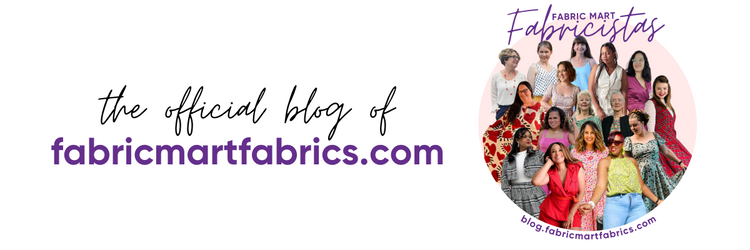When I saw this gorgeous raspberry pink swiss dot chiffon on Fabric Mart's website I knew I had to sew some frosting! I spent a good amount of time in 2023 sewing cake for my newly postpartum body. Since nothing fit the same way, and I had very few nursing-friendly clothes, I made a lot of basics. To start 2024, I figured why not sew some frosting and make a fun date night dress?
Armed with 4 yards of raspberry pink Swiss dot chiffon and 3 yards of magenta polyester lining, I set out to make a special dress. I knew I wanted to make a dress with sheer bishop sleeves to show off the chiffon, but it wasn't until I saw the new Seamwork Frankie dress that I knew it was the perfect pattern for my vision. The Seamwork Frankie dress comes in two versions, the original pattern featuring a gathered skirt, and the bonus pattern with a 6-gore skirt. I much preferred the 6-panel skirt because of the slim A-line silhouette.
I cut out a size 4 bodice and graded out to a size 10 for the waist and hip to accommodate my measurements. I wanted the entire dress to be lined so I cut everything in both fabrics, except for the bishop sleeves which I wanted to be sheer.
If you make a Seamwork Frankie, I highly recommend making a toile at least for the bodice and sleeve. Unfortunately, I did not sew a toile due to time constraints and lack of similar fabric, which I later regretted.
After cutting, I serged the chiffon and the lining bodice pieces together. This stopped the fraying of the chiffon and gave me one solid piece of fabric to work with for the rest of the bodice assembly. For the skirt, I wanted the lining to be free from the chiffon, so I attached all of the lining fabric pieces to make the skirt and then repeated this with the chiffon fabric. The two-layer skirt was then basted at the waist seam and attached to the bodice.
Since I skipped the toile process, I periodically tried things on to make sure the fit was correct. Since the sleeve insertion process is the very last step of the pattern, I had the whole dress fitting perfectly without the sleeves. Once the sleeves were inserted, something went wrong. The top of the sleeve bicep was so tight I felt like my arm was losing circulation. When I tried to get out of the dress, I got stuck in it! After a few moments of sheer panic and thoughts of "what if I have to cut myself out of the dress," I realized that my mother-in-law was visiting that day and she could help me get out of it. Thank goodness she was there because she was able to free me from the dress!
Since the bodice and the skirt fit perfectly without the sleeves, I knew I had to do something to try to fix the sleeves that didn't involve having to remake the entire bodice. After considering my options, I settled on letting out a few of the bodice seams around the arm scye.
The pattern includes a 5/8ths inch seam allowance, so thankfully I had some wiggle room. First, I dropped the back yoke seam and stitched it at 3/8ths inch. Next, I let out the underarm seam to 3/8ths inch and pressed everything well. This gave me some much-needed room in the arm scye.
After letting out the seams, I reinserted the original sleeve with a basting stitch to check the fit. The dress was still way too tight in the bicep area and I got stuck again. I was on the right track, but the sleeve was still so uncomfortable I knew further measures would need to be taken.
Thankfully, I had some extra chiffon fabric. My next idea was to cut a whole new sleeve in a larger size and to widen the arm scye curve of the sleeve a bit. I cut out new sleeves in a size 10 and widened the arm scye curve just a little bit too. Next, I paid extra careful attention to the pattern instructions, just in case I had missed something before during the sleeve insertion. I basted the new sleeve into the dress, tried it on, and slipped out of it with ease! I always struggle to get in and out of dresses with side zippers, but this time I could do it myself, so I counted that a success.
Finally, I had sleeves and a dress that fit correctly so I finalized the sleeve seams. Most people would have expected that working with the chiffon fabric would have been the hardest part of making this dress, but those sleeves gave me a run for my money! The chiffon was a cakewalk!
I'm really happy with how my first make of 2024 turned out and I'm excited to wear my new pink raspberry chiffon frosting dress as soon as I can! Despite my fitting set backs, I hope I've inspired you to stock up on some beautiful Fabric Mart fabric and sew yourself a little frosting this year!
SHAINA | @shaina_sews
Unfortunately Fabric Mart Fabrics sell out quickly!
You can find similar fabrics by shopping the following categories: CHIFFON.










Gorgeous! Love that fabric and pattern choice. It fits you nice too.
ReplyDeletePerfect for Valentine’s Day, and the fit is spectacular! Way to go with chiffon, it is a tough sew.
ReplyDelete